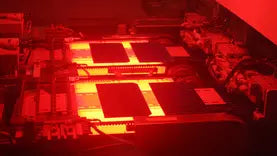https://solarquarter.com/2023/05/12/explained-cost-effectiveness-of-monofacial-vs-bifacial-si-based-pv-modules/
Explained: Cost-Effectiveness Of Monofacial Vs Bifacial Si-Based PV Modules
Monofacial and bifacial Si-based PV modules’ cost-effectiveness is influenced by several variables, including installation costs, energy production, module efficiency, and particular site conditions. When compared to monofacial modules, bifacial modules can absorb sunlight from both sides, which could boost energy production. However, because of their more difficult manufacturing and design processes, bifacial modules typically have higher upfront prices.
In places with high albedo surfaces (such as snow and light-coloured ground), bifacial modules have the potential to produce more electricity than monofacial modules. The increased energy gain can make bifacial modules more effective if the project location has ideal lighting conditions and tilt angles for bifacial module performance.
To optimize rear-side solar capture, bifacial modules may require modifications to the system design and installation, including suitable mounting solutions and ground cover concerns. To assess the viability and potential advantages of bifacial modules, consider the albedo, shadowing, and available space of the site. Due to their more intricate design and additional components, bifacial modules often have higher upfront prices.
Due to their more straightforward design, monofacial modules often have lower upfront expenses than bifacial modules. However, due to their lower energy generation than bifacial modules, monofacial modules’ LCOE may be affected. The LCOE of monofacial modules may be competitive or even lower if site conditions do not considerably favor the rear-side energy gain of bifacial modules. While bifacial modules, which can collect sunlight from both sides, have the potential to produce more electricity. The greater energy production can help to overcome the bifacial modules’ higher initial costs. The LCOE of bifacial modules can be lower compared to monofacial modules provided the site conditions are favorable, such as high albedo surfaces and ideal tilt angles.
Some additional information on the cost-effectiveness of monofacial vs bifacial Si-based PV modules:
Energy Production: When compared to monofacial PV modules, bifacial modules can produce more electricity. Albedo, module tilt angle, and shading conditions are a few examples of the variables that affect the additional energy gain. Depending on the site-specific factors, studies have indicated that bifacial modules can increase energy yield by 5% to 30%.
Installation Fees: Since bifacial modules feature more intricate designs and extra parts like glass or translucent backsheet, they typically have higher installation fees. However, the price of installation may differ based on the chosen mounting method and the particular site circumstances.
The Levelized Cost of Electricity (LCOE) is a frequently employed metric to evaluate how cost-effective PV systems are. It compares the total amount of power produced to the total costs (including finance, installation, operation, and maintenance) incurred over the system’s lifetime. When the higher initial costs of bifacial modules are offset by their enhanced energy generation, their LCOE may be lower than that of monofacial modules.
Payback Period: The amount of time needed to recoup the original investment through energy savings is indicated by the payback period. Particularly in locations that are conducive to bifacial performance, bifacial modules may have a shorter payback period than monofacial modules due to their potential for enhanced energy generation.
Site-Specific Considerations: Site-specific elements like albedo, ground cover, and module tilt angle affect how cost-effective bifacial modules are. Bifacial modules’ rear-side energy uptake is increased on higher-albedo surfaces like white roofs or snow-covered ground, which increases their efficiency and lowers their cost. The location and the amount of sunlight available must be taken into consideration when determining the best tilt angles.
It’s vital to keep in mind that the viability of monofacial or bifacial modules can change based on the geographical region, project size, and market dynamics. Solar project developers can make an informed choice by thoroughly evaluating these elements and conducting in-depth financial and technical assessments.







